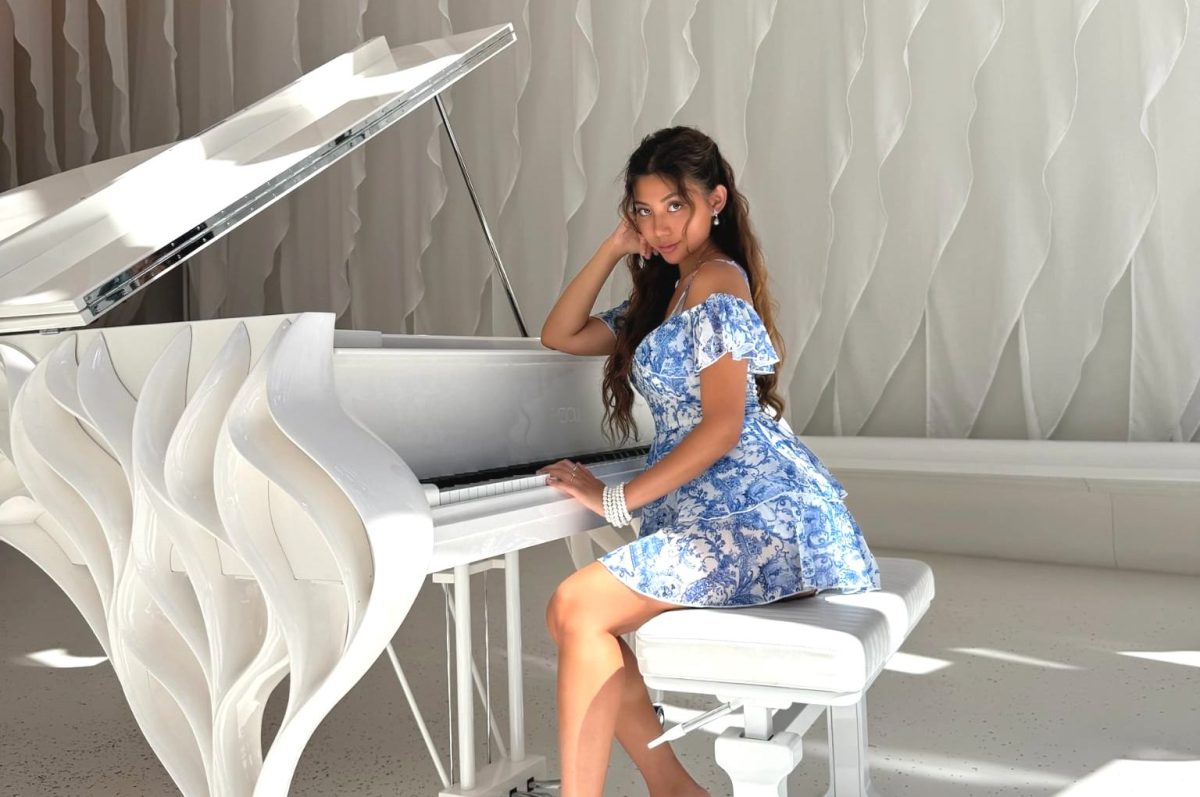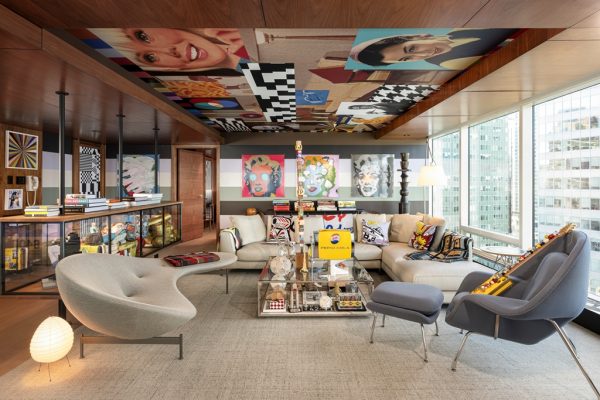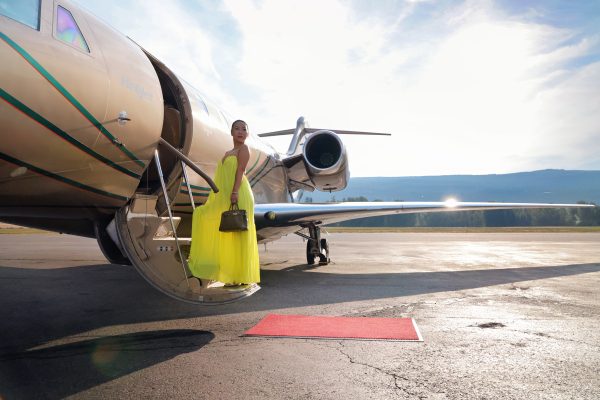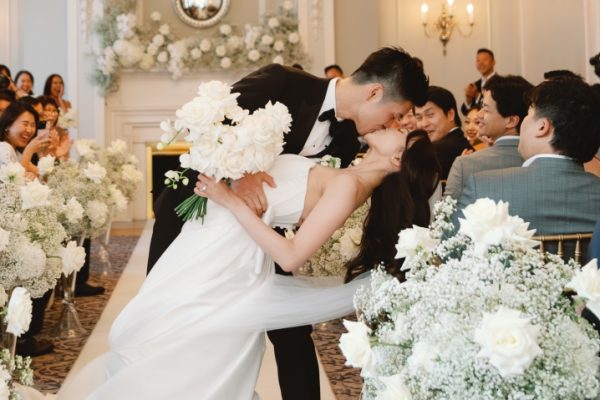Bathed in soft light that drifts through glass and curve, the Butterfly Piano rests like a living sculpture at the heart of The Butterfly building. Its polished surface mirrors the rippling architecture that surrounds it, while the air hums with quiet reverence. The lobby feels alive — an orchestration of light, space, and intention — where form and feeling exist in graceful balance.
Custom-crafted by Fazioli, the piano’s white contours echo the tower’s organic geometry, creating a visual and emotional harmony that invites pause. Yet, the connection between the building and the piano extends beyond aesthetic design. Both draw from a shared muse — the ethereal artistry of Alexander McQueen’s Oyster Dress from his Spring/Summer 2003 Irere Collection — a creation that, like the architecture and the instrument, captures the beauty of transformation through movement, structure, and light.

THE BUILDING THAT BREATHES
The Butterfly rises from downtown Vancouver like a living sculpture. Its curved, undulating form was designed to echo the wings of a butterfly, softening the skyline with movement and grace. The structure embodies a sense of transformation — a blending of natural rhythm and urban energy that feels alive. Light flows freely through its contours, creating a meditative balance between strength and delicacy.
Bing Thom’s vision was rooted in emotion and experience rather than monumentality. Much like McQueen’s design philosophy, his architecture spoke of motion, vulnerability, and resilience. The building seems to inhale and exhale with the city, a poetic reflection of life’s dualities.
THE DRESS THAT INSPIRED A LEGACY
When London-born designer Alexander McQueen debuted his Irere collection in 2003, the Oyster Dress emerged as its haunting centrepiece. Crafted from cascading layers of silk that seemed to drift like sea foam, the gown embodied both fragility and ferocity.
According to the Victoria & Albert Museum, McQueen drew inspiration from Roland Joffé’s 1986 film The Mission, imagining a “fantastical and sinister world” surrounded by water and resurrection. The Oyster Dress became a defining moment in fashion for its ability to capture two opposing forces — destruction and beauty, chaos and calm.
It symbolized rebirth, with every ripple of silk echoing the movement of water reclaiming life. Now part of the permanent collection at the Metropolitan Museum of Art in New York, it remains one of McQueen’s most celebrated creations, resonating across disciplines for its power to evoke emotion through form.
That same emotional language flows through The Butterfly. Both the dress and the building exist in dialogue — each defined by fluidity, transformation, and a reverence for the natural world. They express movement not as motion, but as metamorphosis.

THE PIANO THAT CONNECTS THEM
The Butterfly Piano, a custom-made Fazioli grand, was created to echo the architectural rhythm of the building. Its elegant curves, luminous surface, and sculptural presence mirror the softness of McQueen’s silk and the organic energy of Thom’s design. The piano does not merely occupy the lobby — it belongs to it, transforming space into a symphony of line, light, and sound.
In its form and tone, the Butterfly Piano bridges disciplines. It stands as a metaphor for harmony itself — where fashion, architecture, and music coexist as expressions of emotion. The flowing white silhouette invites reflection, much like McQueen’s Oyster Dress, capturing a feeling of rebirth and fluid grace.
CELINE PAOLINI AND THE BUTTERFLY
International pianist and composer Celine Paolini was among the first to play the Butterfly Fazioli, and her connection to it has since become part of its story. Her admiration extends to its tone and temperament.
“The touch and tone of the Butterfly Fazioli when I play are just exquisite,” she explains. “It is more on the mellow, warm side, and anyone who listens to my compositions knows that I usually play slower romantic pieces, which aligns perfectly with this piano.”
Recently, Celine visited the Butterfly Fazioli in its permanent location, reuniting with the instrument that had first inspired her years earlier. As she played, the sound seemed to merge with the building’s form — soft, fluid, and introspective. Her music, like McQueen’s design, tells stories of transformation, drawing listeners into a shared emotional space between fragility and strength.
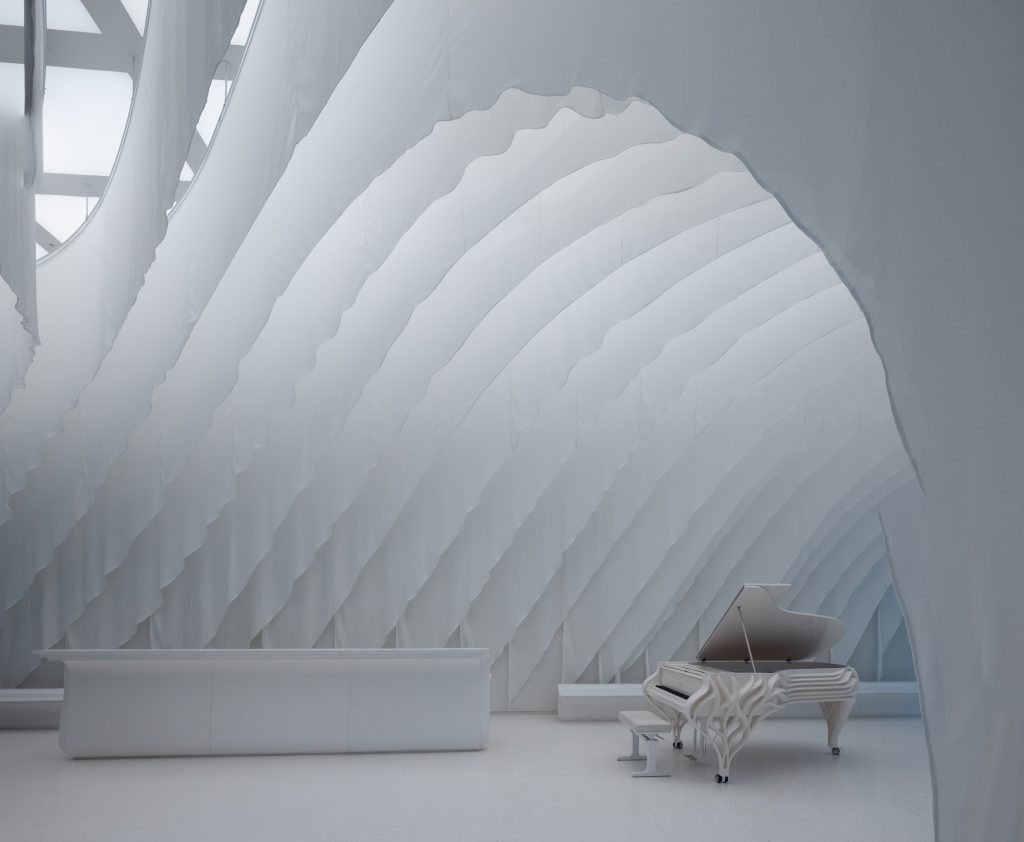
Image: Ema Peter
WHERE ART TAKES FLIGHT
Together, The Butterfly, the Fazioli Piano, and McQueen’s Oyster Dress form an unspoken conversation across art forms. Each piece captures the essence of metamorphosis — the idea that beauty can emerge from tension and rebirth.
Alexander McQueen explored it through silk, Bing Thom through architecture, Fazioli through craftsmanship, and Celine Paolini through sound. In their union, we are reminded that artistry, in all its forms, is a dialogue between stillness and motion — a moment suspended between what was and what will be.
The Butterfly, in every expression, continues to take flight.
Author Profile

- Helen Siwak is the founder of EcoLuxLuv Communications & Marketing Inc and publisher of Folio.YVR Luxury Lifestyle Magazine and PORTFOLIOY.YVR Business & Entrepreneurs Magazine. She is a prolific content creator, consultant, and marketing and media strategist within the ecoluxury lifestyle niche. Helen is the west coast correspondent to Canada’s top-read industry magazine Retail-Insider, holds a vast freelance portfolio, and consults with many of the world’s luxury heritage brands. Always seeking new opportunities and challenges, you can email her at [email protected].
Latest entries
 FoF ☆ Fashion & LifestyleDecember 17, 2025A New Chapter for Luxury Style: Regal Milano Opens Its Doors in Gastown
FoF ☆ Fashion & LifestyleDecember 17, 2025A New Chapter for Luxury Style: Regal Milano Opens Its Doors in Gastown FoF ☆ CelebrateDecember 17, 2025Choosing the Perfect Wedding Suit Fabric: A Season-by-Season Guide With Bespoke Made Suits
FoF ☆ CelebrateDecember 17, 2025Choosing the Perfect Wedding Suit Fabric: A Season-by-Season Guide With Bespoke Made Suits FoF ☆ Culinary, Wine, SpiritsDecember 17, 2025An Evening at CedarCreek Estate Winery in the Okanagan
FoF ☆ Culinary, Wine, SpiritsDecember 17, 2025An Evening at CedarCreek Estate Winery in the Okanagan FoF ☆ Fashion & LifestyleDecember 17, 2025Curating The High Life: David Amos & The Ever-Evolving World Of ‘The Boutique’
FoF ☆ Fashion & LifestyleDecember 17, 2025Curating The High Life: David Amos & The Ever-Evolving World Of ‘The Boutique’
